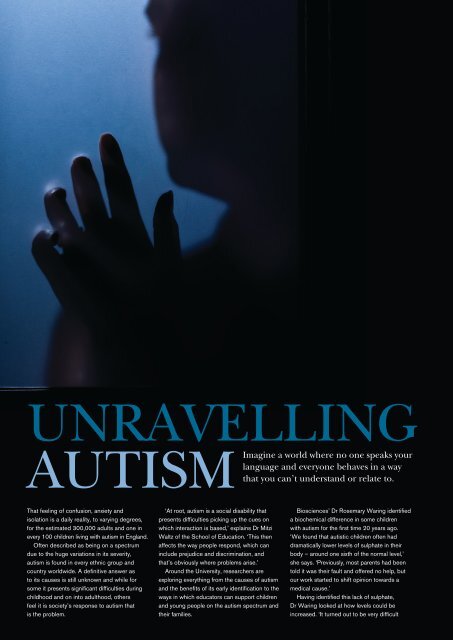What's the difference? - University of Birmingham
What's the difference? - University of Birmingham
What's the difference? - University of Birmingham
You also want an ePaper? Increase the reach of your titles
YUMPU automatically turns print PDFs into web optimized ePapers that Google loves.
24 The <strong>Birmingham</strong> Magazine<br />
UNRAVELLING<br />
AUTISM<br />
Imagine<br />
a world where no one speaks your<br />
language and everyone behaves in a way<br />
that you can’t understand or relate to.<br />
That feeling <strong>of</strong> confusion, anxiety and<br />
isolation is a daily reality, to varying degrees,<br />
for <strong>the</strong> estimated 300,000 adults and one in<br />
every 100 children living with autism in England.<br />
Often described as being on a spectrum<br />
due to <strong>the</strong> huge variations in its severity,<br />
autism is found in every ethnic group and<br />
country worldwide. A definitive answer as<br />
to its causes is still unknown and while for<br />
some it presents significant difficulties during<br />
childhood and on into adulthood, o<strong>the</strong>rs<br />
feel it is society’s response to autism that<br />
is <strong>the</strong> problem.<br />
‘At root, autism is a social disability that<br />
presents difficulties picking up <strong>the</strong> cues on<br />
which interaction is based,’ explains Dr Mitzi<br />
Waltz <strong>of</strong> <strong>the</strong> School <strong>of</strong> Education. ‘This <strong>the</strong>n<br />
affects <strong>the</strong> way people respond, which can<br />
include prejudice and discrimination, and<br />
that’s obviously where problems arise.’<br />
Around <strong>the</strong> <strong>University</strong>, researchers are<br />
exploring everything from <strong>the</strong> causes <strong>of</strong> autism<br />
and <strong>the</strong> benefits <strong>of</strong> its early identification to <strong>the</strong><br />
ways in which educators can support children<br />
and young people on <strong>the</strong> autism spectrum and<br />
<strong>the</strong>ir families.<br />
Biosciences’ Dr Rosemary Waring identified<br />
a biochemical <strong>difference</strong> in some children<br />
with autism for <strong>the</strong> first time 20 years ago.<br />
‘We found that autistic children <strong>of</strong>ten had<br />
dramatically lower levels <strong>of</strong> sulphate in <strong>the</strong>ir<br />
body – around one sixth <strong>of</strong> <strong>the</strong> normal level,’<br />
she says. ‘Previously, most parents had been<br />
told it was <strong>the</strong>ir fault and <strong>of</strong>fered no help, but<br />
our work started to shift opinion towards a<br />
medical cause.’<br />
Having identified this lack <strong>of</strong> sulphate,<br />
Dr Waring looked at how levels could be<br />
increased. ‘It turned out to be very difficult







![Benyamin Asadipour-Farsani [EngD Conference abstract]](https://img.yumpu.com/51622940/1/184x260/benyamin-asadipour-farsani-engd-conference-abstract.jpg?quality=85)









